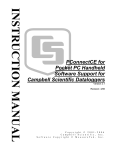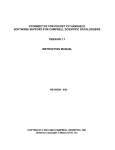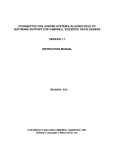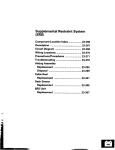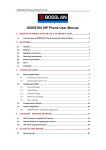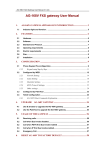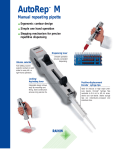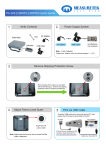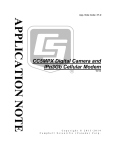Download PConnect Manual
Transcript
PCONNECT FOR THE PALM HANDHELD SOFTWARE SUPPORT FOR CAMPBELL SCIENTIFIC DATALOGGERS VERSION 2.1 INSTRUCTION MANUAL REVISION: 2/03 COPYRIGHT © 2001-2003 CAMPBELL SCIENTIFIC, INC. Software Copyright © MeasureTek, Inc. This is a blank page. License for Use This software is protected by both the United States copyright law and international copyright treaty provisions. You may copy it onto a single Palm or 100% compatible handheld computer to be used and you may make archival copies of the software for the sole purpose of backing-up CAMPBELL SCIENTIFIC, INC. software and protecting your investment from loss. All copyright notices and labeling must be left intact. This software may be used by any number of people, and may be freely moved from one handheld computer location to another, so long as there is not a possibility of it being used at one location while it’s being used at another. The software, under the terms of this license, cannot be used by two different people in two different places at the same time. For example, if you want to install it on two Palm devices at the same time, you must have two licenses. Limited Warranty CAMPBELL SCIENTIFIC, INC. warrants that the installation compact disk (CD) on which the accompanying computer software is recorded and the documentation provided with it are free from physical defects in materials and workmanship under normal use. CAMPBELL SCIENTIFIC, INC. warrants that the computer software itself will perform substantially in accordance with the specifications set forth in the Instruction Manual published by CAMPBELL SCIENTIFIC, INC. CAMPBELL SCIENTIFIC, INC. warrants that the software is compatible only with Palm1 and 100% compatible handheld computers running Palm OS Version 3.3 and later. CAMPBELL SCIENTIFIC, INC. is not responsible for incompatibility of this software running under any operating system other than those specified in accompanying data sheets or Instruction Manuals. The above warranties are made for ninety (90) days from the date of original shipment. CAMPBELL SCIENTIFIC, INC. will replace any CD or documentation that proves defective in materials or workmanship without charge. CAMPBELL SCIENTIFIC, INC. will either replace or correct any software that does not perform substantially according to the specifications set forth in the Instruction Manual with a corrected copy of the software or corrective code. In the case of significant error in the documentation, CAMPBELL SCIENTIFIC, INC. will correct errors in the documentation without charge by providing addenda or substitute pages. If CAMPBELL SCIENTIFIC, INC. is unable to replace defective documentation or a defective CD, or if CAMPBELL SCIENTIFIC, INC. is unable to provide corrected software or corrected documentation within a reasonable time, CAMPBELL SCIENTIFIC, INC. will either replace the software with a functionally similar program or refund the purchase price paid for the software. CAMPBELL SCIENTIFIC, INC. does not warrant that the software will meet licensee’s requirements or that the software or documentation are error free or that the operation of the software will be uninterrupted. The warranty does not cover any CD or documentation that has been damaged or abused. The software warranty does not cover any software that has been altered or changed in any way by anyone other than CAMPBELL SCIENTIFIC, INC. CAMPBELL SCIENTIFIC, INC. is not responsible for problems caused by computer hardware, computer operating systems or the use of CAMPBELL SCIENTIFIC, INC.’s software with non-CAMPBELL SCIENTIFIC, INC. hardware. ALL WARRANTIES OF MERCHANTABILITY AND FITNESS FOR A PARTICULAR PURPOSE ARE DISCLAIMED AND EXCLUDED. CAMPBELL SCIENTIFIC, INC. SHALL NOT IN ANY CASE BE LIABLE 1 PConnect is a trademark of MeasureTek, Inc., Palm OS and HotSync are registered trademarks of Palm, Inc. FOR SPECIAL, INCIDENTAL, CONSEQUENTIAL, INDIRECT, OR OTHER SIMILAR DAMAGES EVEN IF CAMPBELL SCIENTIFIC HAS BEEN ADVISED OF THE POSSIBILITY OF SUCH DAMAGES. CAMPBELL SCIENTIFIC, INC. is not responsible for any costs incurred as result of lost profits or revenue, loss of use of the software, loss of data, cost of re-creating lost data, the cost of any substitute program, claims by any party other than licensee, or for other similar costs. LICENSEE’S SOLE AND EXCLUSIVE REMEDY IS SET FORTH IN THIS LIMITED WARRANTY. CAMPBELL SCIENTIFIC, INC.’S AGGREGATE LIABILITY ARISING FROM OR RELATING TO THIS AGREEMENT OR THE SOFTWARE OR DOCUMENTATION (REGARDLESS OF THE FORM OF ACTION; E.G., CONTRACT, TORT, COMPUTER MALPRACTICE, FRAUD AND/OR OTHERWISE) IS LIMITED TO THE PURCHASE PRICE PAID BY THE LICENSEE. 815 W. 1800 N. Logan, UT 84321-1784 USA Phone (435) 753-2342 FAX (435) 750-9540 www.campbellsci.com Campbell Scientific Canada Corp. 11564 -149th Street Edmonton, Alberta T5M 1W7 CANADA Phone (780) 454-2505 FAX (780) 454-2655 Campbell Scientific Ltd. Campbell Park 80 Hathern Road Shepshed, Loughborough LE12 9GX, U.K. Phone +44 (0) 1509 601141 FAX +44 (0) 1509 601091 PConnect Table of Contents 1. Introduction.................................................................1 1.1 New in Version 2.1 ...................................................................................2 2. Software Installation...................................................2 3. Connecting Your Palm Handheld to the Datalogger..............................................................4 3.1 Direct Serial Connection...........................................................................4 3.2 RF400 Radio Communication...................................................................5 3.3 IR Communication....................................................................................6 4. Using the PConnect Software....................................6 4.1 4.2 4.3 4.4 4.5 Configuring Stations .................................................................................6 Connecting to the Station..........................................................................9 Viewing Data on the Handheld ...............................................................14 Viewing Datalogger Programs ................................................................16 Transferring Data to Your Desktop Computer........................................16 i This is a blank page. PConnect for the Palm Handheld1 1. Introduction Welcome to PConnect for the Palm Handheld support software for Campbell Scientific's CR10(X), CR500/510, CR23X, 21X, and CR7 dataloggers. PConnect software allows you to connect your Palm handheld to a Campbell Scientific datalogger to perform all of the standard datalogger support functions, including: • check and set the datalogger clock • send and receive datalogger programs • view and edit input locations and labels • set flags and ports • collect data • view data in tabular and graphical displays • access the datalogger’s remote keyboard mode through a terminal interface PConnect stores collected datalogger data in the Palm handheld’s internal memory or its memory expansion card. Using the data viewing feature, you can view this data while at the site. When the Palm handheld is HotSync’d with the desktop computer, this data is moved to a specified data folder on the PC. New data from each station is appended to any existing data file on the PC with the same station name. The HotSync process also synchronizes datalogger program files (*.DLD and *.FSL) between the PC and Palm device. Files copied to the Palm device's PConnect\palmname folder will automatically be transferred to the Palm during the next synchronization process. Using this process, you can store DLD files on the Palm device, and subsequently send them to the datalogger or use them for labels when viewing measurements (input locations). Labels from an FSL file that matches the DLD file name will be used when viewing data. You can also retrieve programs from dataloggers to the Palm device, and use the HotSync process to copy them to the PC. If two different programs—one on the Palm device and another in PConnect’s programs folder on the PC—have the same name when you HotSync, the DLD on the PC will overwrite the DLD on the Palm device. (Note: PConnect does not support collection from Campbell Scientific Storage Modules or Card Storage Modules.) 1 PConnect is a trademark of MeasureTek, Inc., Pam OS and HotSync are registered trademarks of Palm, Inc. 1 PConnect for the Palm Handheld 1.1 New in Version 2.1 The following new features have been added in PConnect 2.1: • Collected data can be saved to Palm memory cards • Collected data files can be deleted from the Palm (in previous versions, files were deleted only when the Palm was synchronized with the computer) • PDA to datalogger communications support for Campbell Scientific's RF400 radios • PDA to datalogger communications support for Campbell Scientific's SC-IRDA infrared interface device 2. Software Installation PConnect requires a Palm OS based handheld running Palm OS version 3.3 or higher (for example, Palm III, V, VII, M100 or M500 series, and models of the Handspring Visor series with the necessary OS version) and an IBM compatible PC computer running Windows 95, 98, ME, NT, 2000, or XP and Palm HotSync Manager software version 3.0 or later. NOTE PConnect has been tested on various Palm and Handspring devices running OS versions 3.3 through 4.X. The only OS version 5 device that has been tested is a Sony CLIÉ PEGNX70V. Compatibility issues are not expected with other OS 5 devices but cannot be guaranteed. First, make sure that you have already installed the Palm Desktop software on your PC. Then, insert the PConnect compact disk into your CD-ROM drive and run the Setup.exe program from the disk (if Autorun is enabled on your computer it will start automatically). Follow the instructions on the screen to install the software. During the installation, you will be prompted for “Destination Location” for the software (the default is c:\program files\campbellsci\pconnect). You will then be prompted to “Choose Working Folder” (default is c:\campbellsci\pconnect) which will be the directory on the PC for the palmname folder where the data files retrieved by PConnect will be saved when you synchronize your Palm with the PC after data has been collected from a datalogger. This will also be the directory into which you will copy any files that should be transferred to the Palm for use with the datalogger, such as a new program file (*.DLD). After you have installed the software on your PC, you must use the HotSync utility to install PConnect on your Palm device. You must HotSync twice— first to transfer the PConnect program, and second to create the working subdirectory (for data and DLD files) for that device in the working directory (see above) on your PC. After installation, you may change the folders for the data and DLD files. Click the HotSync icon on your system tool tray, choose Custom, then select 2 PConnect for the Palm Handheld PConnect and click Change, and then enter a new path for the data and program files. Refer to the steps below: Step 1: Step 2: 3 PConnect for the Palm Handheld Step 3: If you are updating from an earlier version of PConnect, simply run the installation on the PC from the PConnect CD and then HotSync. Data will be preserved and moved to the PC and the PConnect program will be updated on the Palm handheld. NOTE If you are installing the PConnect 2.1 patch, PConnect 2.0 must already be installed on the Palm for the patch to be successful. If you do not have Version 2.0 or greater, contact a Campbell Scientific Applications Engineer for information on upgrading your software. You are now ready to use the PConnect software. 3. Connecting Your Palm Handheld to the Datalogger 3.1 Direct Serial Connection The most common method of connecting the Palm handheld to the datalogger is using a direct serial connection. The Palm handheld connects to the datalogger via the communications port on the bottom of the device. If you do not have one already, you will need to purchase a USB to serial cable for your Palm handheld (a HotSync cable). Since this cable is specific to each Palm OS 4 PConnect for the Palm Handheld handheld model it is not included with the PConnect software, but can be purchased separately from PDA cable retailers. After connecting the HotSync cable to the bottom of the Palm handheld, use the supplied PDA to CS I/O adaptor to connect to the datalogger's CS I/O port: Palm Handheld HotSync Serial Cable (purchased separately) PConnector Adaptor (supplied with PConnect) Datalogger Note that one side of the connector is labeled Datalogger, and the other side is labeled PDA. If the connections are reversed, communication with the datalogger will fail. 3.2 RF400 Radio Communication Two RF400 radios can be used to communicate with the datalogger using the Palm handheld. With this setup, the PDA to CS I/O connector is not used. At the datalogger site, the CS I/O ports of the RF400 radio and the datalogger are connected using an SC12 or similar cable. Power for the RF400 is supplied by the datalogger's CS I/O port pin 8, which supplies 12 V. The Palm device is connected to the base RF400 radio by using an RS232 null modem cable between the Palm's serial connection and the RF400's RS232 port. Typically, this is accomplished by using the Palm's USB to serial cable, with a null modem connector at the end, connecting to the RF400's RS232 port. Depending upon the type of null modem cable used, a gender changer may be necessary. An external power source will be needed for the RF400 base radio, since it cannot be powered by the Palm device. Cables, gender changers, and power supplies can be purchased from local suppliers or from Campbell Scientific. Campbell Scientific offers a Null 5 PConnect for the Palm Handheld Modem Cable Kit (DB9 Male to DB9 Male, P/N 14392) for connecting the Palm device to the RF400 base. Two gender changers (P/N 14393) may be required for use with a customer-supplied null modem cable. The RF400 Base Station Kit (P/N 14220) provides an AC to 12V DC transformer for the RF400. The Field Power Cable (P/N 14291) provides a 12V DC barrel plug on one end for connection to the RF400 and two pigtails on the other end for use with other power supplies such as a vehicle's 12V cigarette lighter accessory. 3.3 IR Communication Campbell Scientific's SC-IRDA infrared interface device can be used to communicate with the datalogger using the Palm device's IR port. The SC-IRDA connects directly to the datalogger's CS I/O port; the PDA to CS I/O connector is not used. Best performance is seen when the Palm is within three feet of the SC-IRDA and the two IR ports are directly aligned. 4. Using the PConnect Software 4.1 Configuring Stations Start the PConnect software on the Palm handheld. PConnect has two main windows: the Stations window and the Datalogger Programs window. You can navigate between the two by pressing the window's name in the upper right corner of the screen. When the software is first stated, the Stations window will appear: Your first datalogger will appear by default with the name of Stn1. You must provide a unique identity for each individual datalogger. To change the station name, as well as other station settings, touch the station name and then the Edit button to bring up the Edit Station Parameters window: 6 PConnect for the Palm Handheld From this window you can change the station Name, associate a Program, select the Datalogger model, enter a Security Code, and select the mode of Communication. The Station name can be any name up to 8 characters. It must contain alpha and/or numeric characters and cannot contain any spaces. A Program File can be associated with the datalogger to provide labels for the input locations when viewing them on the Measurements window. (Note that only DLD files created with Edlog version 2.0 and greater will have these labels stored in the DLD.) If a program is already running in the datalogger and you have a copy of the DLD on the handheld, you can associate the program with the station. To select the file, press the downward pointing arrow, and choose a file. When you download a new program to the datalogger using PConnect, you will be asked if you want the label descriptions to be changed to reflect the new program. The datalogger model of the station is chosen by pressing the arrow to the right of the Datalogger field and selecting the desired datalogger type. Dataloggers may have up to three levels of Security. Security is set when creating the datalogger program or in the datalogger's *C mode. If security is enabled in the datalogger, you may need to enter the four-digit security code to collect data, set the datalogger's clock, and depending upon the level of security, even to connect to the datalogger. Refer to the datalogger's user manual for complete information on security codes. The communication mode can be specified by selecting it from the Communication field. PConnect supports direct serial communication, pointto-multipoint RF400 radio communication, and Campbell Scientific's SC-IRDA infrared device (see Section 3). 7 PConnect for the Palm Handheld When the RF400 is selected, an RF Net Address and an RF Radio Address must be entered. These two settings must reflect the settings in the remote RF400 radio. PConnect will temporarily set the RF base modem's addresses to the addresses specified, and then return them to the previous values after you disconnect. When you are finished editing the station parameters, touch OK. You will be returned to the Stations window. If you will be using the handheld to collect data from more than one datalogger, you will need to create additional stations. To do this, press the New button. 8 PConnect for the Palm Handheld Stn2 will be added to the list of stations. Highlight the station name and press Edit to edit the parameters as required. A station can be deleted by highlighting it and pressing the Delete button. You will be prompted to confirm the deletion. 4.2 Connecting to the Station From the Stations window, choose a station to connect to and touch Connect. The Measurements window will appear, displaying the current input locations in the datalogger. Scroll using PConnect controls Scroll using Palm controls Because of the small screen size, you may see only a few of the input locations in the datalogger. Touch the up or down arrows to the right of the measurement cells to scroll through the values, or use the Palm's scroll buttons to see the additional values. The value of an input location can be changed from the Measurements window. Click within the cell to highlight it, press the Edit Value button that is displayed, enter the new value, and press OK. You can change the descriptive labels for the measurements by clicking within the cell, typing in a new label, and then clicking anywhere on the screen. There are five other windows you can use to accomplish other tasks with the datalogger. They are the Collect Data window, the Set Clock window, the Flags/Ports window, the Terminal window, and the Transfer Program window. To select one of these windows, touch the text that reads Measurements in the upper right corner. The list of windows will be displayed. 9 PConnect for the Palm Handheld Collect Data The Collect Data window is used to collect data from the datalogger and store it to a file on the handheld, which is then transferred to the computer during a subsequent HotSync operation. The data is stored in binary format on the handheld and then converted to a comma-separated ASCII format when the file is transferred to the PC during the synchronization process. 10 PConnect for the Palm Handheld There are three data collection options: Collect Since Last Time - This will collect only the new data that has been stored since the last time data was collected using this handheld. If this is a first data collection attempt, all data will be collected. Collect All - This will collect all data currently in datalogger memory, regardless of whether the data has been collected previously. Collect Last # of Arrays - This will collect only the number of records entered into the Arrays to Collect field that appears when the option is chosen. The default option is Collect Since Last Time. To choose another option, press the arrow to the left of the default option. If PConnect recognizes that a memory card is installed in the Palm, a field will also be displayed to choose whether the collected data is stored on the Palm device or on the card when it is collected. When the handheld is synchronized with the PC and the data file is transferred, the data will be appended to any station_name.dat data file that exists with the same name. During the transfer, the data is converted to comma-separated ASCII format. After the file is transferred, the binary file is deleted from the handheld. Set Clock The datalogger's clock can be set to that of the handheld's by switching to the Set Clock window and touching the Set Clock button. Note that the two clocks may not match exactly, since there will always be some delay between when the command is sent and when it is received by the datalogger. 11 PConnect for the Palm Handheld Campbell Scientific typically advises against frequent routine setting of the datalogger's clock. In most instances, the datalogger's clock will be much more accurate than the handheld's. Setting the clock could result in data with duplicate or missing timestamps, especially if data is being saved in final storage fairly quickly. For instance, assume you are storing 1 minute data. If the datalogger's clock reaches 11:45 and it stores data for that period, and then you set the clock using a handheld whose internal clock reads 11:44, you will end up with two different arrays of data with a timestamp of 11:45. Flags/Ports The datalogger's flags and ports can be viewed and toggled from the Flags/Ports window. All of the flags and ports in the datalogger are displayed on the screen. If a flag or port is High, a check mark will appear in the box beside the flag or port. If a flag or port is Low, the box will be empty. To change the state of a flag or port, touch the box for that flag or port. There may be a short delay between when the box is touched and when the state of the flag or port appears to change. Terminal When Terminal is selected, the remote communications command is sent to the datalogger and it is put into a remote communications state. This state allows the user to send telecommunications command directly to the datalogger and is typically used for trouble-shooting. 12 PConnect for the Palm Handheld Touch abc for Palm keyboard The datalogger's keyboard/display keypad is depicted on the Terminal window. The Palm device's grafitti pad or keyboard can also be used to enter characters. To return the datalogger to its program execution state, enter *0. LOG1, LOG2, or LOG12 should be displayed indicating that the code in program table 1, and/or program table 2, is being run. This option should be used with caution since it is possible to delete instructions in the datalogger's program or delete data from the datalogger while in this mode. Refer to the datalogger's user manual for complete information on the remote communications mode. Transfer Program Switch to the Transfer Program window to send a new program file (DLD) to the datalogger, or to retrieve the program file that is currently running in the datalogger. To send a program to the datalogger, press the arrow beside the DLD file name adjacent to the Send button, and then press the Send button. (Note that if no file has been sent or associated with the datalogger, this field may read "none".) To retrieve a program from the datalogger, enter a name into the field adjacent to the Retrieve button, and then press the Retrieve button. DLD files are copied to the Palm device by placing the file or files in the handheld device's Working Directory folder on the PC (by default, this is C:\campbellsci\PConnect\Palmname). The next time you HotSync with the handheld, the file(s) will be copied. If you retrieve a DLD file from the datalogger, the next time you HotSync with the handheld, the file will be uploaded to the Working Directory for the device. 13 PConnect for the Palm Handheld 4.3 Viewing Data on the Handheld Once data is collected onto your Palm handheld, you can view it in a tabular or graphical format. Click on a station from the Stations window. If there is data in the handheld for that station, the View Data button will be enabled. 14 PConnect for the Palm Handheld When the View Data button is touched, the data for that station will be shown in tabular view. Select an array to graph Touch to view as common separated Double-click a column to graph it To view the data in a comma-separated format, touch the text at the upper right of the window that reads Comma. As you scroll through the data, note that all of the collected arrays are displayed intermixed as they were retrieved from the datalogger. To graph a column of data, you must limit the display to only one array type. Tap the Array ID dropdown arrow and select the ID of the array from which you want to graph data. Double tap the column of interest to graph it. You can scroll back and forth within the data. To see the value and the time stamp of a particular point, just tap that point. If an FSL file with the same name as the DLD file name exists on the Palm column labels, graph labels, and time stamps will be derived from the file when viewing the data. To transfer an FSL file to the Palm, place the file in the PConnect/palmname directory and the file will be copied during the next HotSync operation. A data file can be deleted from the Palm device by pressing the Delete button. You will be asked to confirm the deletion. A data file that has been deleted will not be transferred when the Palm device is HotSync'd with the computer, and it cannot be restored once deleted. 15 PConnect for the Palm Handheld 4.4 Viewing Datalogger Programs To see the datalogger programs stored on the Palm handheld, touch the word Stations in the upper right corner of the Stations window and select Datalogger Programs. A list of datalogger programs will appear: A datalogger program can be viewed by highlighting it and pressing the View button. You can also Delete a datalogger program or Rename a datalogger program by pressing the appropriate button. 4.5 Transferring Data to Your Desktop Computer Once data is collected onto your Palm handheld, you can HotSync with your desktop computer and the data will automatically transfer to the folder you specified during the initial setup (default = C:\campbellsci\Pconnect\palmname). Data is stored on the Palm device in the same binary format as in the datalogger to conserve memory. It is converted to comma-separated ASCII during the HotSync process and appended to the data file on the PC named after the station from which it was retrieved. 16
























